Knuckling in dogs is often the first symptom pet owners notice when their pup is developing a mobility problem. Typically, it starts as a subtle change in your dog’s gait or how your dog stands, but it’s a signal that shouldn’t be ignored.
Table of Contents[Hide][Show]
Knuckling is a warning that something important is starting to go wrong with your dog’s health. It’s a sign that your pet should be seen by a veterinarian, right away.
Understanding knuckling in dogs
Knuckling happens when dogs flip a paw under themselves so that it bends at the wrist. Instead of standing on the pad of the paw, the dog tucks the toes under and walks on the top part of the paw.
Dog knuckling is not the same as limping. When animals limp, they favor the injured leg by lifting a paw to avoid putting weight on it. With knuckling, dogs unconsciously, roll the paw under and stand on the top.
Most of the time, knuckling in a dog, signals that a neurological condition is brewing, but it can also be due to an injury or a musculoskeletal disorder.
The problem usually occurs in the hind legs and typically only one paw, at a time, is affected.
Note: Some of the links in this article are affiliate links. As an Amazon Associate, I earn from qualifying purchases.
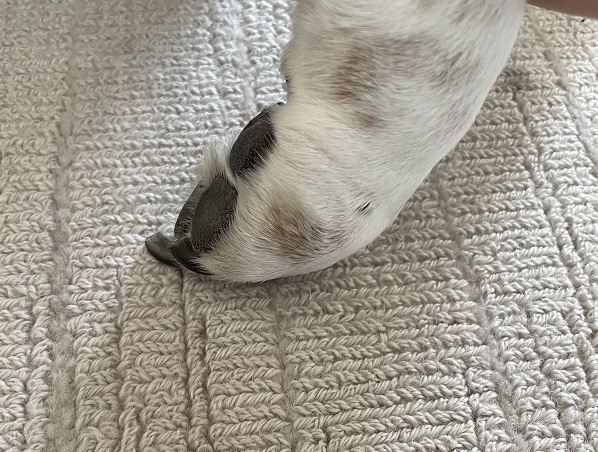
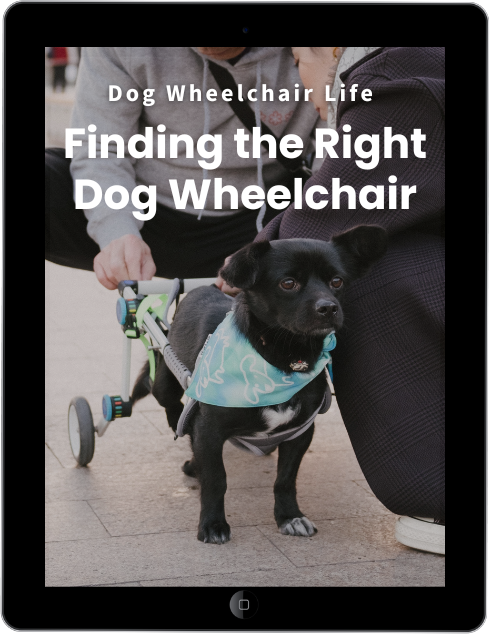
eBook
Find The Right Dog Wheelchair For Your Pet
Your dog has a mobility problem, and you want to buy a wheelchair. But do you know what kind of cart will work best for your dog’s individual needs? After a decade of teaching pet owners how to make the right choice, I put the information into an eBook!
Sophie’s struggle with knuckling
One of the most common causes of dog knuckling is a neurological disease called Degenerative Myelopathy (DM). This is a heartbreaking progressive condition that attacks the spinal cord of adult dogs between the ages of 8-14 years old.
DM struck my dog Sophie when she was ten. Slipping and knuckling were the two symptoms I noticed first. Every time Sophie turned a sharp corner in the house, her back legs slipped out from under her and she fell to the ground.
Soon after, Sophie began to knuckle a rear paw. She would tuck her paw in half when she was standing. Later, she began to walk on the top part of her paw instead of the pad and while it looked odd and painful to me, she never noticed she was knuckling her paw, even when I correctly repositioned it.
I later found out that dogs who knuckle their paws don’t realize it’s happening. They’ve lost the sensations that tell them whether or not they are standing correctly.
Nearly six months later Degenerative Myelopathy caused Sophie’s back legs to become paralyzed, and she was unable to walk at all.
Then the disease slowly moved from her hind limbs to her front legs and finally to her organs. She passed away almost 5 years after her diagnosis.
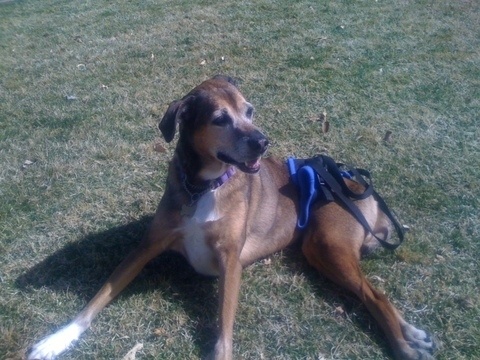
The role Proprioception plays in knuckling
Proprioception is the body’s ability to sense locations. It’s what allows people and animals to walk and move around without having to think about it. Proprioception in dogs gives them the ability to sense their position and actions. It’s what enables a dog to keep his balance and adjust to any changes in the surroundings.
When a dog has good proprioception, he knows where each of his four limbs are, without having to look at them.
Knuckling, on the other hand, is a sign that proprioception isn’t working well and that your dog can’t sense if a paw is positioned the wrong way.
The problem can be caused by medical conditions such as:
- Neurological disorders – Conditions like Degenerative Myelopathy, Intervertebral Disc Disease (IVDD) and spine injuries can all disrupt the communication between the brain and the limbs, leading to dog knuckling.
- Lack of muscle tone – Knuckling can occur when dogs lose muscle tone. It’s often seen in young dogs with nutritional problems and arthritic senior dogs who knuckle a paw to relieve pain.
- Injury – Injuries to the nerves, spinal cord or limbs can reduce proprioception and lead to knuckling.
Recognizing the signs
Learning the early signs of knuckling in dogs can help you get your dog the treatment he needs before the condition gets worse.
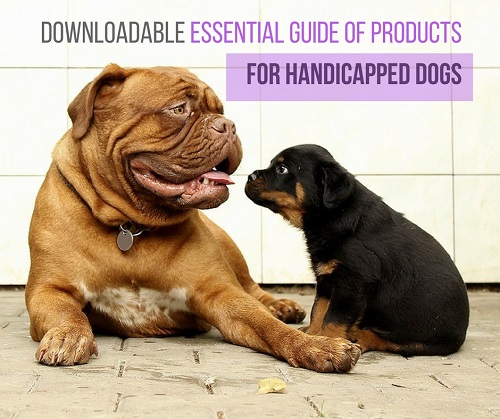
Get the Essential Guide
The Essential Guide of Products for Handicapped Dogs e-book is a labor of love for me. I wrote it to answer your most pressing questions about where to find the best products for your wheelchair dog. You’ll find products you didn’t know existed and each will improve your dog’s quality of life. Print a copy and keep it by your side.
Signs to watch for:
- Dragging a paw – You may notice that your pet avoids using a rear paw and instead lets it drag behind him as he walks.
- Awkward paw placement – Your dog refuses to stand or walk on the pad of a paw and instead curls the top of the paw under the pad.
- Worn nails or scraps on the paw – Knuckling can cause sores on the top of a dog’s paw and wear down the toenails.
- Tripping and stumbling – Falling down or tripping can happen because the dog isn’t walking on the pads of the paw.
What to do if your dog is knuckling a paw
If you notice your knuckling in your dog, it’s important to consult a veterinarian as soon as possible. A thorough examination, including neurological tests and imaging such as an X-ray or MRI may be necessary to determine the cause.
Recovery from knuckling varies depending on the cause and severity of the condition. Some dogs recover after a period of time, while other animals have long lasting symptoms.
Treatment options
Because there are many causes of knuckling in dogs, there are a variety of treatment options available. (Please talk with your veterinarian before starting any the treatments listed below.)
- NSAIDS (non-steroidal anti-inflammatory drugs) can be used to manage pain.
- Laser therapy for quick healing, pain relief and reduced inflammation
- Provide your dog with more traction and stability when they walk with products like ToeGrips for dogs.
- Mobility aids such as a support/lifting harness, Maximus skates, a dog wheelchair or brace that keeps the paw in the proper position all help improve dog knuckling.
- Physical therapy can help dogs with proprioception problems learn how to sense their paws proper location.
- Surgery can be helpful for dogs who knuckle due to IVDD ruptured discs or spinal cord injuries.
Conclusion
Knuckling in dogs is more than an awkward gait or a limp. It’s a sign that your pup might be experiencing a serious health problem. It’s important to recognize the warning signs and seek immediate care for your pet. With prompt attention and treatment, many dogs can regain their mobility and have a good life.

My favorite harnesses for disabled dogs.
Products for dogs who knuckle their paws

Walkabout Toe’s Up
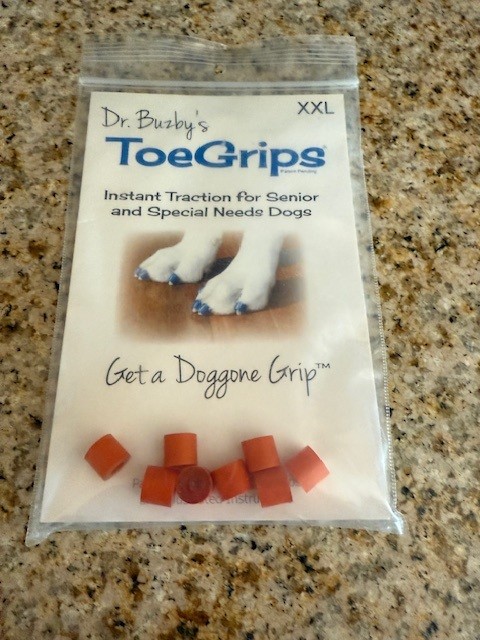
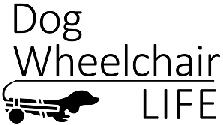
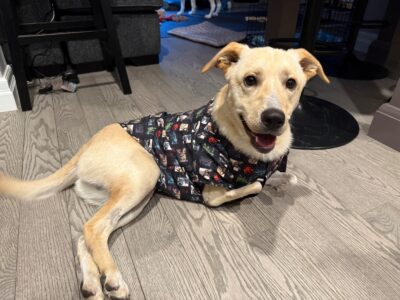
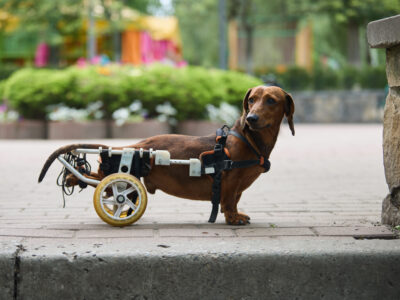
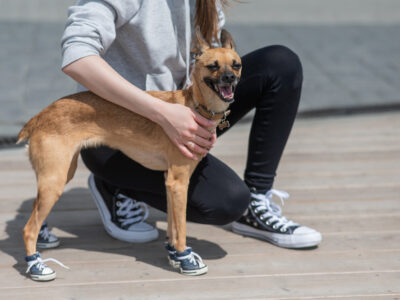

Leave a Reply